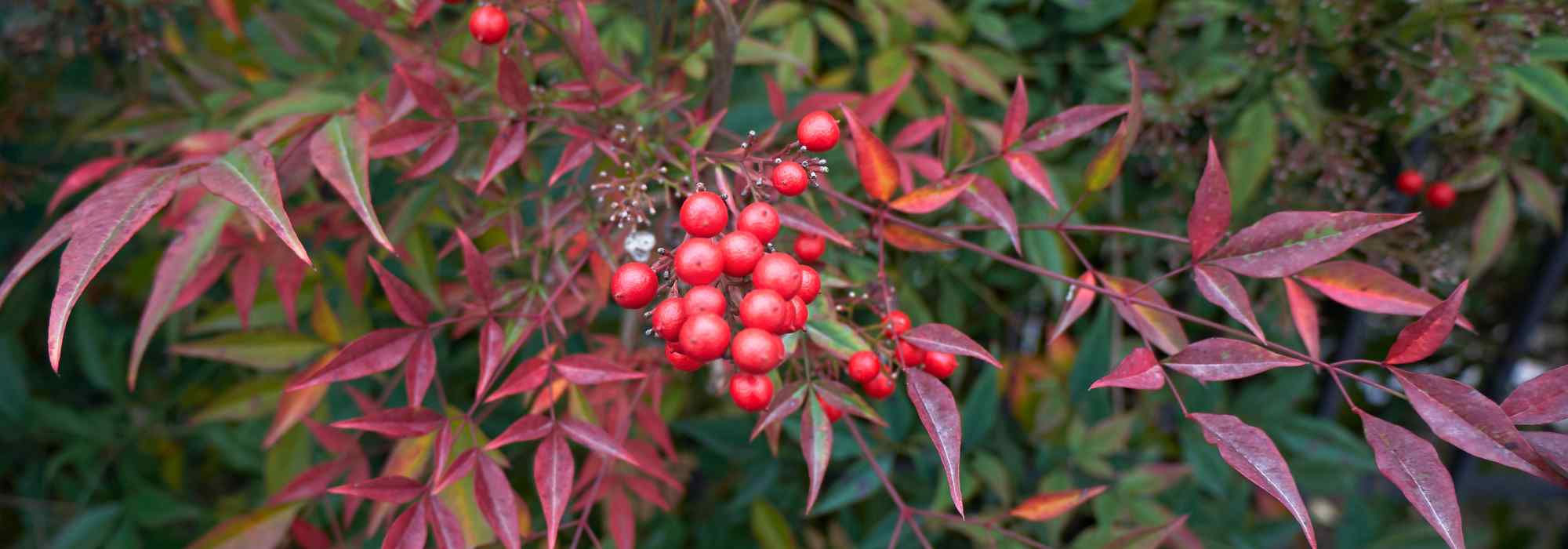
Diseases and parasitic pests of Nandina
Identification, Prevention and Natural Solutions
Contents
Despite their name, the sacred bamboos (Nandina domestica) are actually bushes. Highly ornamental, they boast many qualities: evergreen foliage with evolving colours, delicate flowering and winter-brightening fruiting.
Moreover, these are easy-going plants requiring little maintenance. Though reputedly resistant to parasitic pests and diseases, Nandinas can still suffer from certain cultivation issues. Let’s examine the main problems, how to prevent risks, and which natural treatments to apply if needed.
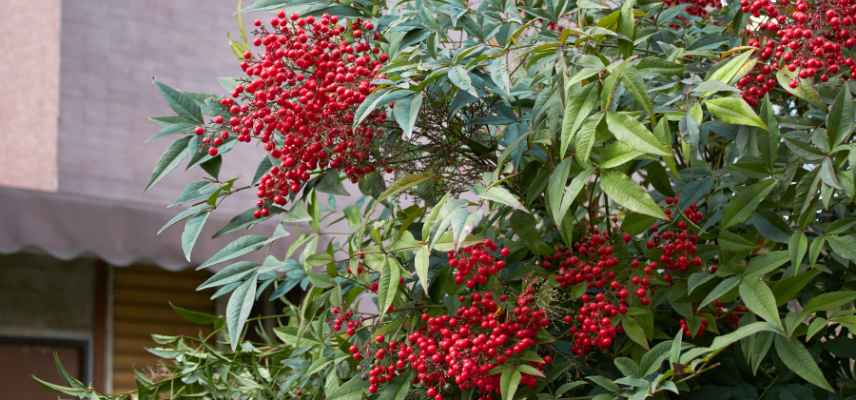
Rarely diseased, sacred bamboos may nevertheless suffer occasional insect attacks
Mealybugs
Description and Symptoms
Scale insects are fairly common garden pests. They are sap-sucking insects that feed on plant sap. There are different types, all quite difficult to detect at the start of an infestation.
The mealybug is recognisable by its white colour. It appears covered in a cottony or waxy powder. The soft scale or hard scale insects have a sort of protective soft shell, dark in colour.
They generally thrive in closed, warm and humid environments. This is why they are mostly found on Nandina grown in urban areas, greenhouses or conservatories.

By feeding on plant sap, scale insects contribute to weakening them. But that’s not all: some, like the mealybug, secrete honeydew, a sticky substance that encourages the appearance of a fungal disease. This is sooty mould. The leaves then turn black, as if covered in soot. They can no longer carry out the photosynthesis essential for the plant’s survival, which can eventually cause it to decline.
The damage caused by scale insects remains however mostly aesthetic. Young plants may be more sensitive, with reduced growth, flowering and fruiting.
The presence of ants may be a clue: they feed on the honeydew secreted by scale insects and, in return, protect them from predators. You’ll notice the pests on the stems and leaves (often on the underside). Upon closer inspection, you may also see whitish cotton-like secretions, brownish spots or sticky droplets on the leaves.
Prevention and Natural Solutions
To prevent infestations, it’s important to regularly inspect your sacred bamboos. This allows you to intervene at the first signs of pests, before they multiply and spread to other plants. Because it’s not easy to completely get rid of scale insects.
At the start of an infestation, clean the leaves with a damp cloth to remove the pests. Additionally, you can apply a natural insecticidal treatment based on black soap. To do this, dilute one tablespoon of black soap (choose pure soap) and one tablespoon of vegetable oil (such as rapeseed oil) in one litre of lukewarm water. Pour into a spray bottle. Shake and spray onto the aerial parts of your Nandina. Preferably do this in the evening. Repeat after a week if necessary. Note that this insecticide, although natural, is not selective: if other insects like bees or ladybirds visit your Nandina, they may also be affected. So check that they are absent before treating.
At the same time, improve the growing conditions for your sacred bamboos. A struggling plant is a weakened one, more susceptible to parasitic attacks and diseases. Provide them with well-drained soil, in a non-scorching spot sheltered from strong winds. Avoid excess nitrogen (fertiliser), which makes stems and foliage softer and more appealing. If your Nandina is grown indoors, ventilate regularly and move it outside if possible during the warmer months. Don’t hesitate to give it a light shower too.
Finally, in the garden, aim to promote natural balance, to also welcome the predators of pests. Several measures can be applied for this: preserving wild corners in the garden, growing melliferous plants, installing shelters, nesting boxes and water sources, banning all chemical products, etc.
To learn more, read our article: « Scale Insects: Identification and Treatment »
Aphids
Description and Symptoms
Aphids are another very common small pest. Green, black, winged or not, there are different types. All feed on plant sap. While their presence rarely causes a Nandina to wither, it can affect its growth, cause leaf deformation, or even affect flower buds. The damage is therefore mainly aesthetic.
But as with scale insects, aphids secrete honeydew which serves as a substrate for sooty mould. They are also protected by ants in return.
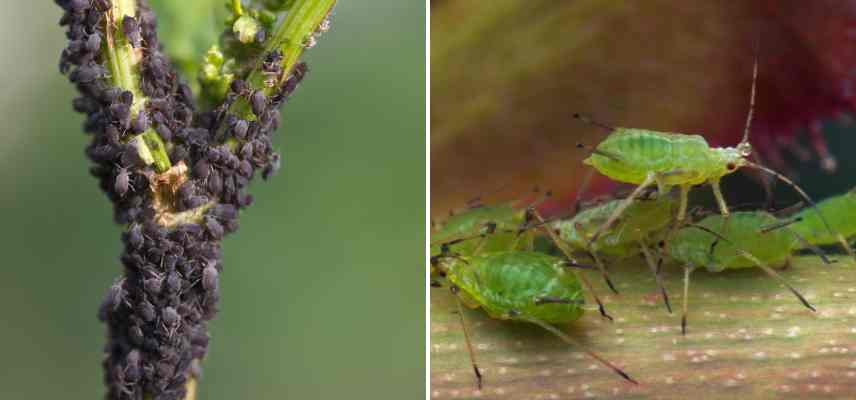
Prevention and Natural Solutions
The methods of action are the same as for scale insects.
- Regular observation, to act as soon as the first aphids appear.
- Manual removal using a cloth or a jet of water.
- Attention to growing conditions.
- Spraying with a natural insecticidal soap solution in case of a large colony.
Tansy manure is also known for its repellent properties against aphids: worth trying.
To protect crops, you can also use trap plants. They attract pests to divert them from the plants you want to protect. For managing aphids, particularly nasturtium is useful, as it tends to naturally attract them.
To learn more, check out our article: Aphids: Identification and Treatment
Disease
Description and Symptoms
This is a disease transmitted by sap-sucking insects, particularly aphids and scale insects mentioned earlier. When they pierce the plant to feed on its sap, these small pests can simultaneously inoculate pathogenous agents (much like mosquitoes can do when they bite us). The disease causes stunted leaf growth, which becomes narrower, smaller, and may even become deformed. Leaves may also curl in on themselves or become discoloured.
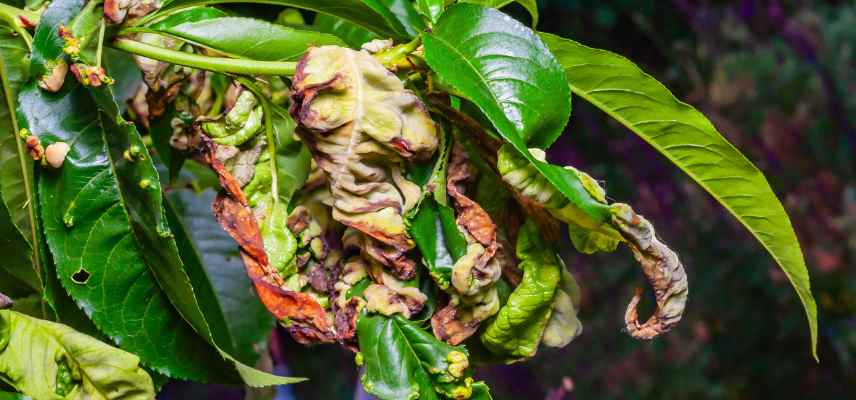
Symptoms of the disease on a peach tree
However, the damage is almost purely aesthetic: it is rare for a Nandina to die from this disease, unless the plant was already severely weakened due to unsuitable growing conditions. That said, the disease can spread from one Nandina to another if several young plants are grown close together.
Prevention and Natural Solutions
Prevention involves monitoring aphids and scale insects to avoid the development of this disease. There is no treatment.
You may try plant-based solutions, particularly nettle and horsetail juices, which are known to benefit plant immune systems. They must be diluted in water (ideally rainwater) and sprayed onto the aerial parts. You can find these in stores, or you can easily make them yourself. To help you, check out our tutorials on making nettle juice or horsetail juice, along with our usage tips.
- Subscribe!
- Contents
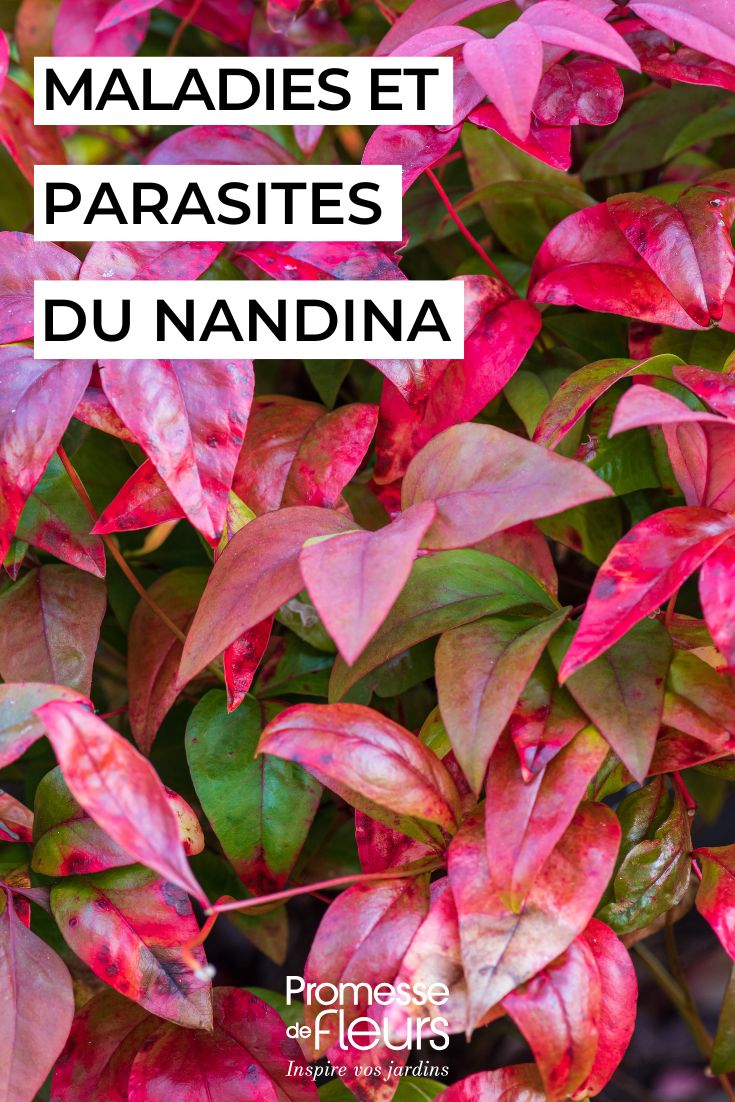































Comments